
Daniel Knorr: Materialization
丹尼尔·克诺尔:物化

「坪山美术馆展览研究档案」
Exhibition Research Archive
采访时间:2022年5月13日
受访人:丹尼尔·克诺尔(Daniel Knorr)
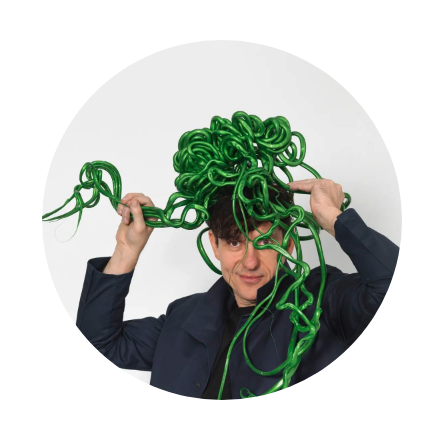
丹尼尔·克诺尔 (Daniel Knorr),1968年出生于罗马尼亚,14岁随父母移居德国,现于柏林和香港工作和生活。自2005年代表罗马尼亚参加第51届威尼斯双年展至今,丹尼尔·克诺尔一直是全球最为活跃的观念艺术家之一,他的创作主题涉及城市公共空间与私人领域之间的关系。在作品中探讨历史、社会政治、经济等领域,在他特有的艺术语境中提出问题并试图讨论。最为人熟知的是2017年第14届『卡塞尔文献展』装置作品《呼气运动》Expiration Movement,大量的浓烟从弗里德利希阿鲁门主展馆的瞭望塔上冒出,甚至引起卡塞尔当地的许多居民打电话给消防局。文献展的宗旨也让我们回顾历史,在70多年前,博物馆在二战中被摧毁,浓烟四起,作品带来对战争的反思。
Daniel Knorr, born in Romania in 1968, moved to Germany with his parents at the age of 14, and now works and lives in Berlin and Hong Kong. Since representing Romania at the 51st Venice Biennale in 2005, Daniel Knorr has been one of the most active conceptual artists in the world, working on the relationship between urban public space and the private sphere. In his works, he explores the fields of history, social politics, economy, etc., raising questions and trying to hold discussions in his unique artistic context. His most well-known work is the Expiration Movement, the installation work of the 14th Dokumenta in 2017. A large amount of smoke rises from the observation tower of the main exhibition hall of Friedrich Arummen. It even caused many local residents in Kassel to call the fire station. The purpose of this work also allows us to look back on the history. More than 70 years ago, the museum was destroyed in World War II, and the smoke was everywhere. The work brings reflections on the pandemics.
采访人:柳思扬(Serein Liu)

柳思扬(Serein Liu),非盈利艺术平台Art Flaneur联合创始人。曾任上海chi K11美术馆展览&典藏经理,2019年利物浦LOOK摄影双年展联合策展人,香格纳画廊研究部主管。获英国莱斯特大学博物馆学硕士学位。她的研究关注国际语境下的艺术机构如何解读和诠释社区的陈述、身份和记忆。
Serein Liu is an independent art practicer based in Shanghai. She is the co-founder of Art Flaneur, a non-profit platform that aims to create a comprehensive directory on residency. Previously worked at chi K11 art museum in Shanghai as Exhibition and Collection Manager and ShanghART Gallery in Shanghai as Head of Research. She is also an independent curator.
协同采访:
唐煜婷(典藏研究部)
甘嘉馨(展览部)
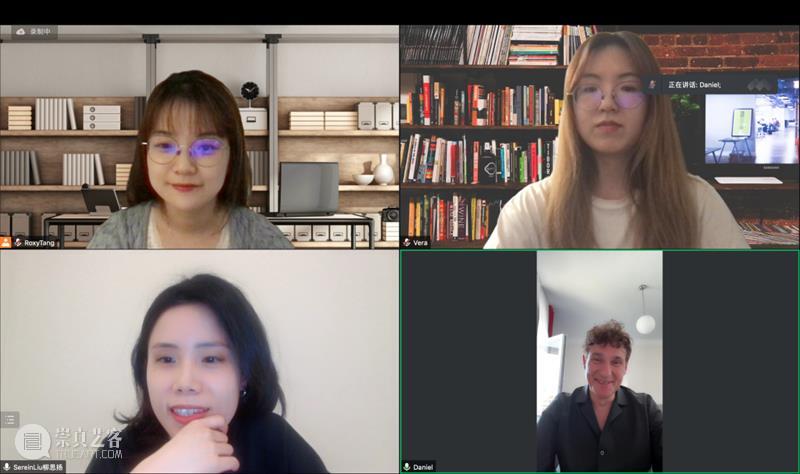
缘起
五年前,当我走进第14届卡塞尔文献展博物馆高塔展区时,第一眼留意到的便是您的作品《失效运动》(Expiration Movement, 2017)。时隔五年,在我翻阅当年的文献展画册时,您的作品仍是我印象最为深刻的一件。机缘巧合,有幸受邀与您就此次展览作一线上对话,共同讨论和回顾您作为艺术家,关于观念灵感、创作材料、趋势转变以及分享展览幕后的故事。
问答
1. 这是您在国内美术馆的首次个展对吗?
Daniel Knorr:是的,这是一次很棒的展览。事实上,我真的惊喜于能够拥有如此宽阔的空间,因为通常来说这筹办和策划这样规模的展览不是一件容易的事。我很希望能有机会亲自前往,但受目前形势所限,这一愿望仍颇为遥远。你知道,有时心愿和现实之间会有沟壑,这或许在所难免。
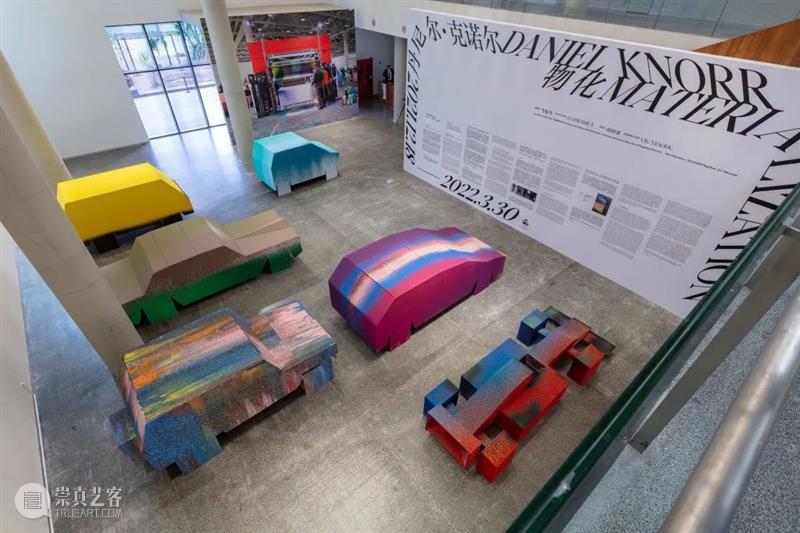
作品《洗涤》1F,《物化》展览现场,2021-2022,️©坪山美术馆
2.我相信这次展览只是一个开始,在未来,您会有更多机会来中国许多不同的城市,将您精彩的作品呈现给更多观众,并与我们在线下有更多面对面交流的机会。说到您的作品,我非常好奇它们的创作方法,比如您会事先绘制草图吗?能否简述一下您是如何将“观念”转变为“物质”的、即“物化”的过程?
Daniel Knorr:感谢将这个问题作为出发点,这也是一切的“起点”。在观念艺术家的脑海中,当一个想法浮现,它会自然而然地激发材料本身“被物化”。对我来说,这些作品均基于观念本身,随后它们会自行吸引合适的材料来塑造各自的实体形态。事实上,我创作的很多作品都经过了不同的物化方式,比如我曾经创作的一件名为《克劳斯,克劳斯走着来》(Klaus, Klaus comes by foot, 2001)中,主角克劳斯曾是一名美术馆安保人员,但当我在一场开幕活动中将其匿名带到大家面前时,他变成了一件艺术作品。这种“物化”的方式与这次展览中的作品《书法假发》(Calligraphic Wig)并不一样,相较之下,《书法假发》的作品形态其原型来自于欧洲一家回收塑料的公司,处理废弃塑料的机器一旦损坏时,就会出现像作品中一样的有趣外形——看起来很像一种语言符号不是吗?所以我便留意到这一新奇发现,并把他们提炼出来重新通过3D打印的方式编排成作品。我只是将形态有趣的东西从它们原本的日常中抽取出来,但当它们激发并试图打破我的视觉经验的同时,我想观众可能一样会有所触动。
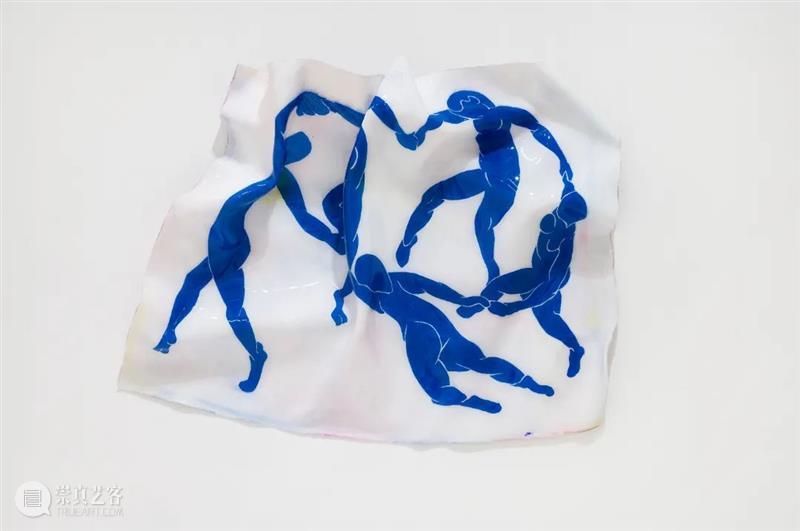
「画布雕塑系列」舞蹈,2021,抗紫外线聚氨酯 可变尺寸及颜色,152×200×40cm,《物化》展览现场,2021-2022,️©坪山美术馆
3.《书法假发》也是一件鼓励人们走近观看甚至走进体验的作品。当您在脑海中构思这件作品时,您是否曾设想过观众将如何与之互动?这种互动会否反哺或影响您的创作?
Daniel Knorr:这件作品首次展出于香港重庆大厦。大厦中林立着商铺长廊,其中一间大约25平方类似铺面的空间内,《书法假发》最初便是在那里面向观众。当时的展陈设想与“打扰”相关,你知道,在那样一处人群众多且复杂的居住环境中,人们在现实境况下的生存状况是被各种因素干扰着的。例如,大厦里有这样一间屋子,里面居住着来自19个不同国家和地区的人,他们各自都有着于我们而言非常不同的文化背景和语言。在那样一个多元文化所存在的地方,我的想法便是观察他们是如何参与到对方的起居生活之中、又是如何一起生活在同一个狭小空间的。因此,我觉得若是将展览空间打开一个入口让观众自行进入,可能会非常有意思;但与此同时,我当时并没有对人们会如何和我的作品以及空间进行互动有任何预想,我仅仅是在那里,看着人们穿梭其中。说回到这次展览中的《书法假发》,其展示空间要比香港那件大得多(在我的想象中,它应该像是一个丛林),如果有机会的话我仍然非常希望能够站在一边静静地观察观众是如何感知它、并与之“互动”。
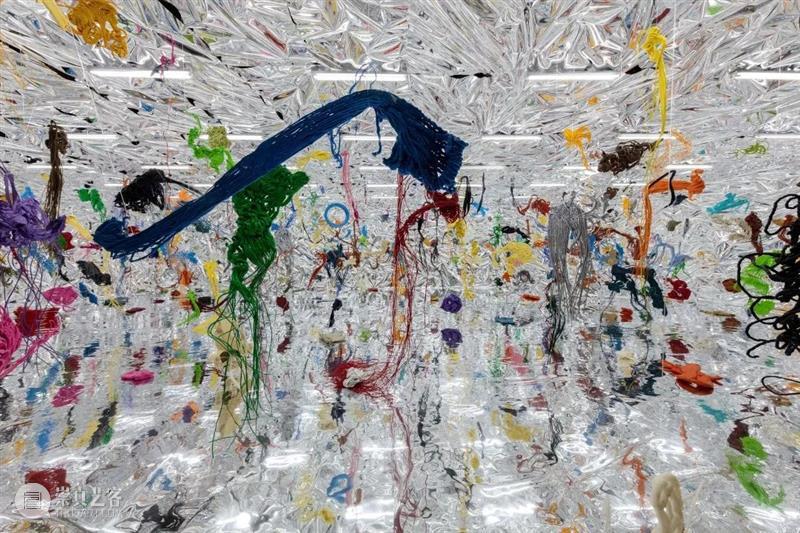
作品《书法假发》3F,《物化》展览现场,2021-2022,️©坪山美术馆
4.这让我想到了您的另一件作品,《洗涤》(Laundry),同样曾在欧洲展出过。但当时的展览现场可能更倾向于是一个表演型现场,通过“洗车机器”和“车子”被“清洗”的过程,观众会看到更完整的作品产生过程。关于“车”的概念,您是否旨在呼应一种工业化符号、或一些工业生产国家和地区的文化语境?以及同样的,“洗车”的场景是否来源于生活实景或其他;与车有关的场景,为什么唯独选择了“洗车”?
Daniel Knorr:是的,其实在这场展览设想之初,我们有考虑过增设器械、为观众现场还原“洗车”全过程,但迫于限制最终这一表演未能在深圳实现。这系列作品的灵感(用画布拼接组合成“车”)最早是在2014年发生的,但当时我还没有想清楚要在画布上画些什么;后来我在互联网上偶然看到了一些洗车的图片,忽然之间我就想到了或许可以像洗车一样给我的“车”上色!当时恰逢巴塞尔艺术博览会,受艺博会启发,这一整套想法得以整合成为一件完整的作品。一开始,我只是在博览会现场,表演“画布汽车”的洗车过程,但当车子穿过“洗车间”时,五彩斑斓的颜料随机落在一块块画布上,我才发现这种作画方式的奇妙之处:整辆“车”非常自然而夺目。起初我所感兴趣的只是这件作品的现场表演部分,直到那届巴塞尔艺博会结束的时候,我们把立体的“汽车”拆解开来,才发现发散式喷射在单张画面上的点彩颜料组合也非常的不可思议。(译者注:在坪山美术馆二楼中庭可参观作品《洗涤》中“画布汽车”的平面展开形态)
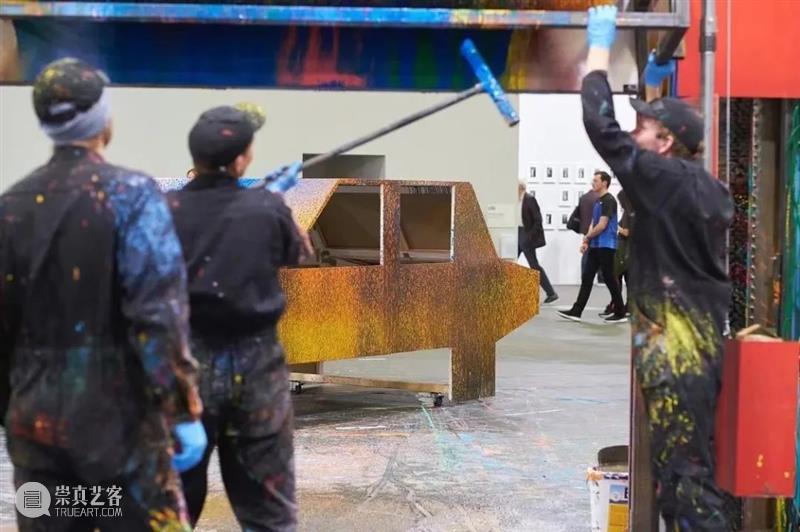
Art Basel现场表演,2019年,瑞士巴塞尔,️Daniel Knorr
5.我非常好奇的是,《洗涤》中每辆“车”的颜色是否都有考虑到这辆车的原产国文化和工业文明的关联?同时,“艺术品生产”如今看来其趋势愈发工厂化,与传统艺术中所强调的“直觉”和“情绪”相比,您如何看待艺术品制作中的工业化环节?
Daniel Knorr:这么说或许大家会更有体会:当你开始着手做一件作品的时候,其实你可能根本不知道何时意味着“制作完成”,就像在试验阶段,你也可以随时喊停。在《洗涤》中,我所追求的原本只是一场现场表演以及将“洗车”过程尽可能完整地实现,所以当时的画布本身非常简单,随后慢慢地,我开始考虑如何控制和搭配颜料,比如是在车子两侧和顶部均使用四种颜色组合,还是两侧颜色少一些,更多地集中到车顶。判断颜色测试可否的依据来源于直觉,以及凭借直觉,我们相信亦可以将颜色实验直接呈现于艺博会观众的面前,同时收取他们的反馈。再到后来,我们陆续设计了不同的“汽车模型”,比如“面的”,它的造型和表面的黄色颜料源自上海的出租车,但同时黄色作为出租车的颜色,在国际上也具有很高的认同识别度;再比如劳斯莱斯、吉普和法拉利,有时我们会大胆地将各种颜色混合在一起,最终得到一种泛着金属光泽的、像是现实场景中使用的略微有些脏旧的灰棕色,当然,每一辆“车”在设计和制作之时,我都有不同的考虑,感性来说,每辆“车”都应有其自己的“角色”和“性格”,正因如此,他们对不同的人来说或许也意味着不同的文化符号和现实经历。

新作品《Peel P50》(2022)由近50块画布构成,通过3D建模还原了世界上最小的车。©️Daniel Knorr
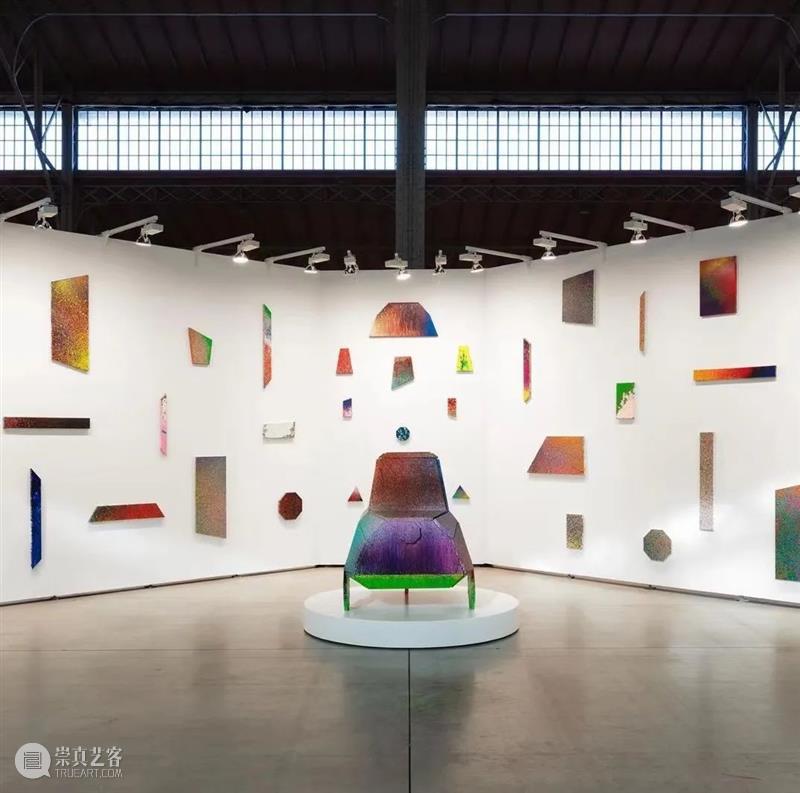
Peel P50 及其拆解展示墙,Spark艺博会,2022年,️Daniel Knorr
6.我们研究您的作品时发现,《画布雕塑》(以及孪生系列《凹陷海拔》)较之您其他创作,从视觉和审美角度来说非常与众不同。能谈谈您是从何时、以何种形式开始实验聚氨酯这种媒介材料的吗?
Daniel Knorr:那是2013年,我在洛杉矶的一家画廊参展期间的发现。我们作为艺术家,每天必行之事便是思考和实践关于空间和时间的种种观察与理解,一次偶然的机会当我行走在当地街道上时,我发现地面有洞孔之处的水漩涡有着非常有趣的动态形式。但是你知道,洛杉矶是一座在沙漠中建造的城市,它很少下雨,所以地面上经常仅仅可见洞孔。于是我们找来水,往这些地面上的小孔里倒水,才得以复现水涡。实验了几次后我们觉得水涡的形式在视觉和审美上都很独特,于是接下来的问题是:如果作为作品呈现,它的外形应该看起来是什么样的?(选用何种材料呈现想要的“外在形式”)后来在洛杉矶当地的一家商店里(他们也为诸如好莱坞等提供富有创意的材料),我找到了一种上好的玻璃物质(聚氨酯),它高度显色,且无味和抗紫外线。与《画布雕塑》的聚氨酯实验同样有趣的发现之旅,《凹陷海拔》所使用到的材料可以从洛杉矶这家店铺运输至全球,于是我买了一些送回柏林工作室进行制作。
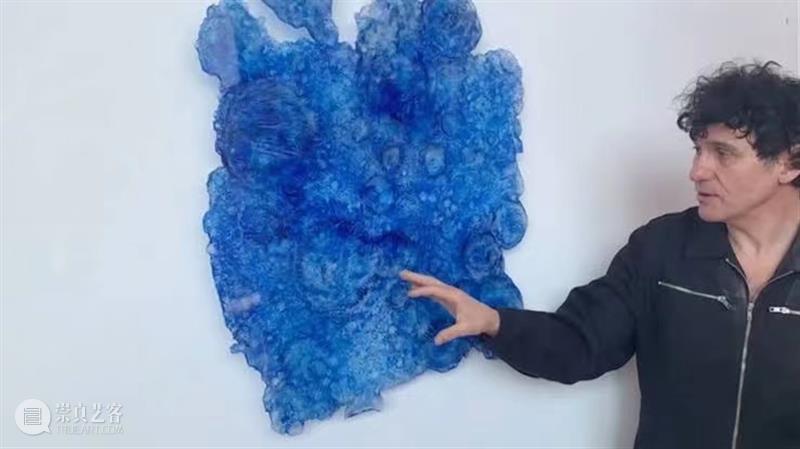
Daniel在讲解作品《凹陷海拔》的视频截帧,2021年 ©️Daniel Knorr
7. 请问作为这次展览的艺术家,您与策展人是如何决定展出哪些类型的作品的?以及考虑到展览空间、地域文化背景、人群观念等,您是否思考过关于作品在当地产生的文化效应和评论反馈?
Daniel Knorr:在作品选择和展览策划方面,我曾与本次展览的策展人李振华先生有过诸多讨论,得益于他对美术馆空间和本土文化的熟悉程度,许多展览的考量都由他最终决定。事实上,很多作品是专门为了这次展览和坪山美术馆所做,比如30多件《画布雕塑》,这是一批基于欧洲传统油画和古典文化的作品。我或多或少也很期待看到我的作品呈现方式及它们所映射的文化语境,会否在中国观众面前成为一种观看和理解的新挑战。在中国促成并实现一场展览,对外国艺术家来说无疑是很不同也很特别的,当然在全球各地做展览也都有着各自不同的惊喜与挑战,但我觉得作品和所呈现的空间地点之间总会存在某种联结,只是各不相同罢了。尽管我无法亲自前往这次展览,但通过前期大量的作品运输和远程筹备,线上看着展览逐渐成型,最终它按时并以很高的质量开幕了。我仍要感谢我的朋友滕斐、深圳红树林画廊,还有振华以及美术馆团队,许多朋友都对这次展览的实现有着莫大的帮助。如果我们可以以这种新的方式做一场展览,何乐而不为?
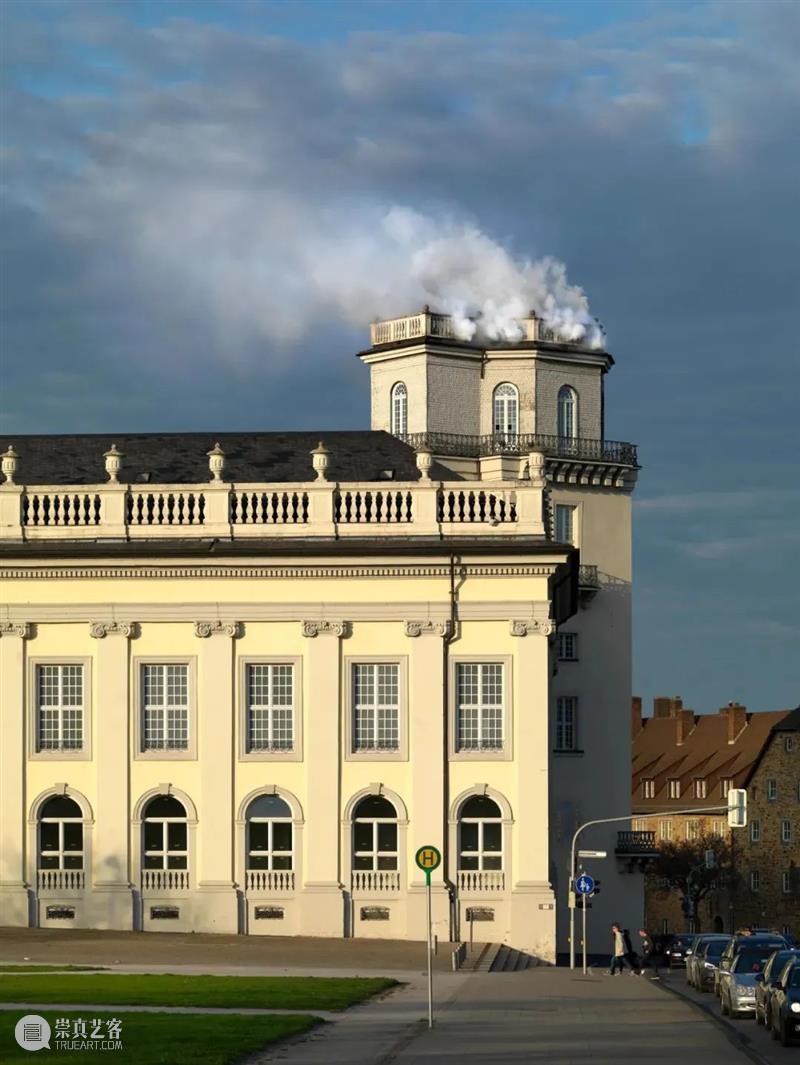
「失效运动」,德利希安农博物馆,2017年第14届德国卡塞尔文献展
8. 您如何看待中国乃至亚洲当代艺术?在当今疫情和国际局势之下,您是否有感受到艺术有任何转变?
Daniel Knorr:以前,我们仍会区分欧洲市场和亚洲市场,但现在我觉得不同的文化正在逐渐消除边界,不妨说我们在分享着同样一个全球化文本。在作品方面,毫无疑问上世纪九十年代左右的中国艺术家所创作的作品,受当时思潮影响,有着非常强烈和直接的风格取向;目前的中国作品较之当时有了更多元的发展。比起强调局势环境和个人身份标签,我更热衷于做一些有助于当下以及未来的作品。有时候,我们会建构一些能够呼应或是与当下对话的创作,它们也许会启发不同的问题思考和我们观察世界的角度。
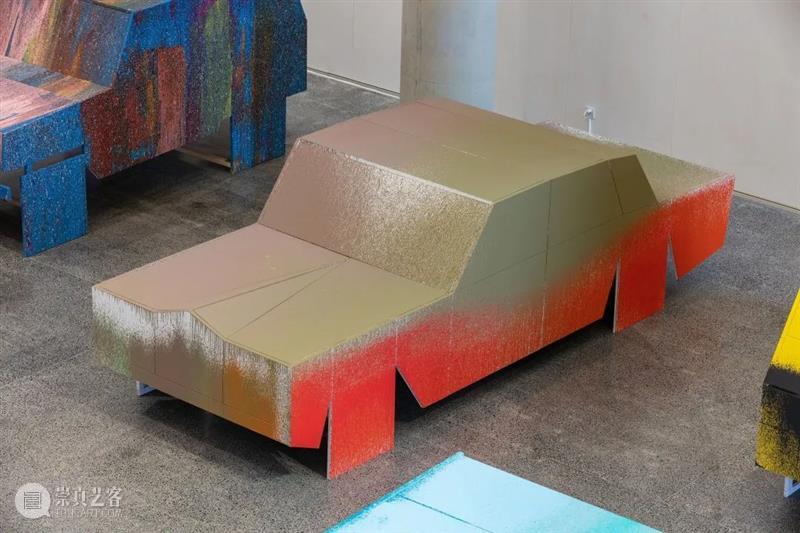
《洗涤,劳斯莱斯》,尺寸可变,改装过的洗车设备,画布,丙烯颜料,表演者,《物化》展览现场,2021-2022,️©坪山美术馆
9.您平日里除了创作以外的生活是怎样的?
Daniel Knorr:平日里,我每天都醒来特别早,喝完一杯咖啡后我便会外出散步,大概到七八点左右返回工作室开始半小时左右的晨间阅读。有时这样的生活也会被打破,比如有新的展览开幕或是旅行安排。
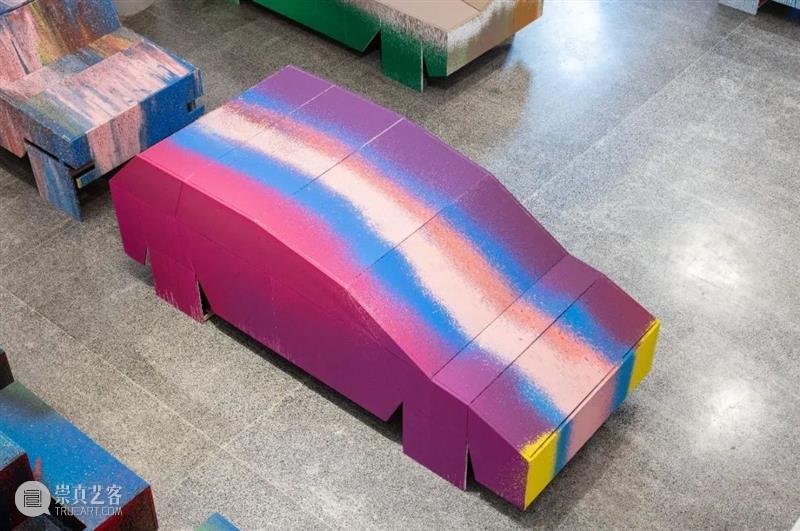
《洗涤,比亚迪》,尺寸可变,改装过的洗车设备,画布,丙烯颜料,表演者,《物化》展览现场,2021-2022,️©坪山美术馆
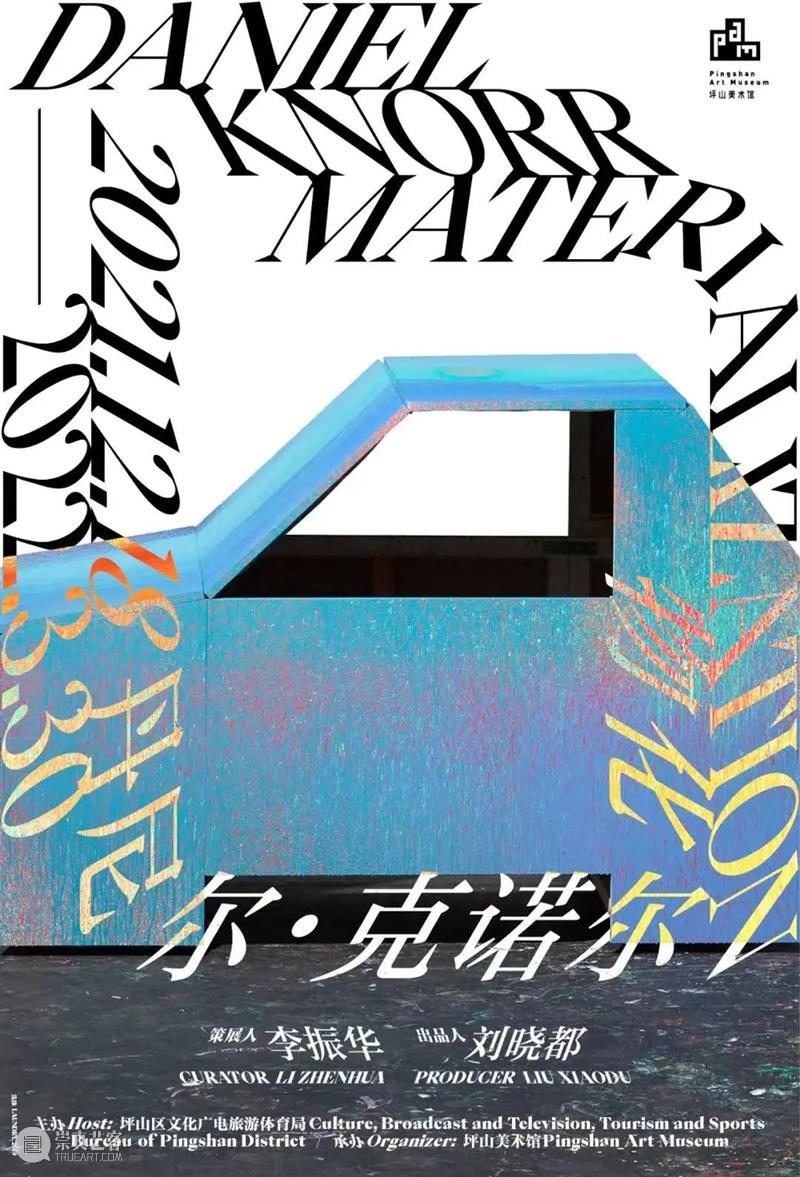
Genesis
Five years ago when I was at Dokumenta 14, your work in castle venue was actually the first one I noticed over there. It’s such a pleasure to have this interview with you. And today, when I went through the dokumenta catalogue, your work Expiration Movement is still one of the most impressive.
Q&A
1. Is this your first solo exhibition in China?
Daniel Knorr:Yes it’s a great show actually, and you know it’s not usual to have such a big space and I was really amazed when I know the museum, and I would love to come and see it but that how it is sometimes. It’s like a dream come through but I haven’t got the chance to see it in person, you know.
2. I believe it’s just the beginning, and people here in different places will know your name with the inspirational works, dialoguing with you. I’m very curious about your methodology of making art?Do you sketch? How do you turn your conceptual ideas into physical works?
Daniel Knorr:Thanks for this question and it’s actually how everything occurs. Let’s say, in the mind of the artist, the idea appears and it triggers various materials to be materialized. I did different works and they’ve been materialized in different ways, for me it’s conceptual background and which is the start point of my works, then you know, it materialized whatever it needs in a physical way. A visible work that I did calls “Klaus comes by foot”, and it was a present Claus and actually he’s a former guard of a museum, suddenly he became an art piece when I took him to an opening in the museum. Instead of bringing him to the people and saying, “Hey this is Claus”, I didn’t tell anyone who he is and just letting him be there. It’s differently ‘materialized’ and also be different from the show in Shenzhen, as you know we have “Calligraphic Wig” and idea came from a recycling company that recycles plastic, when the machine breaks, it makes such kind of ‘calligraphic’ look-like things, you know, somehow it looks like language, so I produced this kind of weird notes and made them materialized. I was wondering those objects and just poured them out from their daily process then printed them out. In another way, the interesting objects also trigger your attention and sometimes break your visual tradition.
3. “Calligraphic Wig” is a work that takes audience in once they are in or around that space. When you were mapping that work in your mind, did you ever anticipate how audience would react? The interaction with them or their involvement in or around your work, will those also influence or feed your practice?
Daniel Knorr:The work initially was presented in a mall in Hong Kong, the Chungking Mansions. It was one of the shops in-between, it’s a small place, around 25 square meters or something. It was also the idea of interrupting, you know, there exist quite a multi-layered people live in there, and the realistic existence of their place was totally interrupted by let’s say the development. For instance, there’s room having 19 nations together, and they all came from different places, having different cultural background and totally different languages that was new to all of us. You know it’s a multi-cultural place, so it was this idea of engaging all of them together. I think it would be interesting to show how people move in so we opened one door and let people in, however, I was not anticipating how they would react but it’s still interesting to watch people walked through. Compared to the Shenzhen one, the space is much bigger so that people may feel like in a jungle (somehow, I just have it in my mind it would be look like a jungle), I also would love to know how people react to it, you know.
4. This reminds me of your work “Laundry”, which was exhibited at various places as well. It was a performance that people could see how cars being ‘washed’ through a specially designed equipment. Do you think the ‘car’ in Laundry actually refers to an industrialized symbol in certain regions or under certain cultural context? Among all the ideas about automobile, how did “car washing” or “laundry” come to your mind? Is there a particular trigger for this?
Daniel Knorr:Yes, in fact at the beginning we were thinking to have a performance of car making and washing in front of people in Shenzhen as well, and to some extend have everything shown for people. It would be also interesting to have all the machine and show the whole process in the exhibition space you know. Also, for the idea (doing cars out of canvas), it came to my mind in 2014, although initially I didn’t know what to put on the canvas, but later when I saw something on the Internet, it’s actually carwash, I don’t know how but it came to my mind, “oh you know with car washing, I could paint these cars!” Then the Art Basel was happening, influenced by the business fair and structure, it became a piece of work. The paint was over everywhere and it went to the surface when I manipulate canvases as cars and car-washing process. Then I discovered that these singular canvases when they came together and random paints fell, it’s actually quite nice. Before I was only interested in the performance, as the performance was the work, but at the end of the Art Basel, when we finally separated the canvases and realized that the colors were super nice in a way of spreading, and some singular pieces driven people to see as well.
5. I’m also curious about the color you choose of each “car”, and do they refer to any industrialized culture background? Also, “art-making” nowadays has also been becoming industrialized. What do you think of the industrialized process while making art?
Daniel Knorr:You know the things are always like, when you start making something, you actually don’t know where it ends, in another words, you can also finish it immediately at the first trial, that’s it. But in this case, it was about to make a live performance, also the cars were very simple in a way, and my first idea was to really make it happen. My attention was on how to control the colors, for example, once we have four colors on each side, left or right or also on the top of the cars, and when time went through, I also tried less color on both sides and more on the top, etc. So, you could also regular the color, then we decided to test the color by our instinction on the Art Basel, in front of our audience and to notice their immediate reflections. It’s actually where this piece of work started and it could be very particular. Now we also compose different models of cars, different colors and sizes, for different spaces and exhibitions. If you take the “Miandi” for example, it’s a car (taxi) from Shanghai, we gave the color yellow as it’s also a quite international recognized color of taxi. Sometimes we also mixed all the colors to get a mild grey, brown, in this way, the color might be look like a golden, dirty and object-based color (Rolls-Royce). And for the Jeep and Formula ones, they were considered and treated also in different ways. So the colors themselves must have their roles, I mean characters, as what do they symbolize and what is the specialty to different people.
6. Both “Canvas Sculpture”and “Depression Elevation”are rather different from some of your other works, visually, aesthetically and conceptually. When and how did you start to experiment with these new materials?
Daniel Knorr:Once upon the time when I was invited by a gallery based in LA, 2013, I noticed the local streets and got interest in the form like a kind of hole in the system. You know we are always thinking and practicing all day long to try to get different understandings of the space and time, so it was the time that I started to utilize the form of puddles or holes in the streets, and I recreated them in my studio using silicon. Also, the city Los Angeles was built in a desert where lacks rain, so you don’t often see the puddles but only holes, so we were wandering around and putting some water into these holes to see the form of the puddles. So we decided to take this attracting form, but the question to me is: how should the work looks like? Then I found the material in a local shop (it’s also a creative industry for Hollywood) which’s like a kind of superb glass (polyurethan), and it has no smelling and UV resistant, very high quality. It can be delivered all over the world so I shipped some to Germany when I went back to my studio and made my new works.
7. Considering the space, cultural and political context, ideology, how did you decide the selection of artworks for this exhibition in Shenzhen?
Daniel Knorr:In the terms of work selection and display methods, I was also discussed a lot with Zhenhua, the curator of this exhibition, and it was his thoughts, about the pieces of works. Actually we did this proposal especially for this museum, and eventually I made around 30 Canvas Sculpture that are particularly for China. More or less, also referring to my way to approach these works, having the chance to challenge content from a traditional European culture, the exhibition happening in Shenzhen would set a new context to a group of different audiences. Play the role as an artist in China must be much different and special, so as it would be in other places. I think there always a connection between the place and the work, maybe just differently. Although it’s a pity that I couldn’t be there in Shenzhen but made the large-scale of shipping and saw the installation process online, gradually it came up. It was really great and everything’s on time, my friend Fei and my gallery Ben and Stefanie, Zhenhua and the museum crew, you know, everyone helped a lot. If we could make a show like this, why not?
8. What do you think of Chinese and Asian contemporary art? Do you feel that there have been changes over the years?
Daniel Knorr:Like we used to have the European market and Asian market, nowadays from my perspective of view, art also different cultures are becoming boundary merged, let’s say we are sharing a global context. In terms of artwork, for sure the work made in 90s, which were influenced by a strong and direct artistic wave, now apparently, it’s developed from that moment. Instead of emphasizing who I am and my identity, I’m more interested in the time we live in, and I feel like that I have to do something for the moment and the future. Sometimes, the way we compose a piece of work or start a conversation of the situation, it also inspires different angles to look through the world and time we are living, and could help to rethink and rebuild our value system maybe.
9. Apart from your studio life, how is your daily life in Berlin and how do you usually spend your day?
Daniel Knorr:What I usually do is like I wake up quite early in the morning and have a cup of coffee, and I go outside and return home at 7 or 8 in the morning, then I read for half an hour maybe. Sometimes interruption may happen, like openings or travelling.
展览参观信息| Visiting Info
作品《洗涤》1F&2F,《物化》展览现场,2021-2022,️©坪山美术馆
作品《书法假发》3F,《物化》展览现场,2021-2022,️©坪山美术馆
作品《大众是谁?》4F,《物化》展览现场,2021-2022,️©坪山美术馆
线上访问| Online Viewing Room
作品《洗涤》1F,《物化》展览现场,2021-2022,️©坪山美术馆
展览视频| Video
丹尼尔·克诺尔:展览纪录片
统筹、编辑及翻译|唐煜婷
编辑|李子莹
审校|刘晓都 李耀
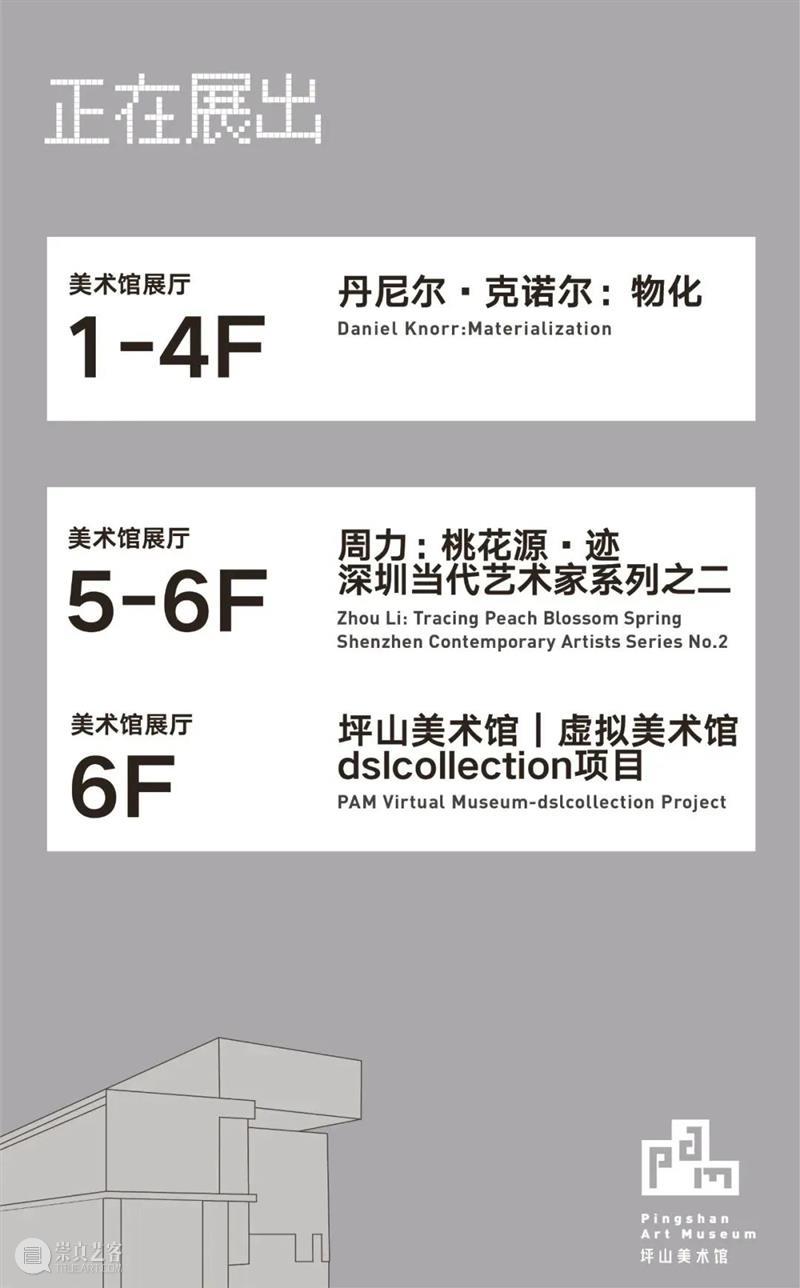
温馨提示
根据坪山区最新疫情防控要求,入馆参观需出示72小时核酸检测阴性结果证明、健康码及行程卡。敬请大家合理安排参观时间,错峰参观、分时预约、间隔游览。感谢您的理解与支持!
● 坪山美术馆采取限流开放,实行预约进馆制(可线上或现场扫码预约);
● 线上预约路径:关注坪山美术馆公众号-点击底部菜单栏“预约观展”并填写参观信息;
● 现场扫码进馆:在美术馆入口处扫码登记、出示健康码并经测温正常后入馆参观;
● 预约限额、开放时段等信息以预约系统为准;
● 系统提前三天开放预约。



已展示全部
更多功能等你开启...
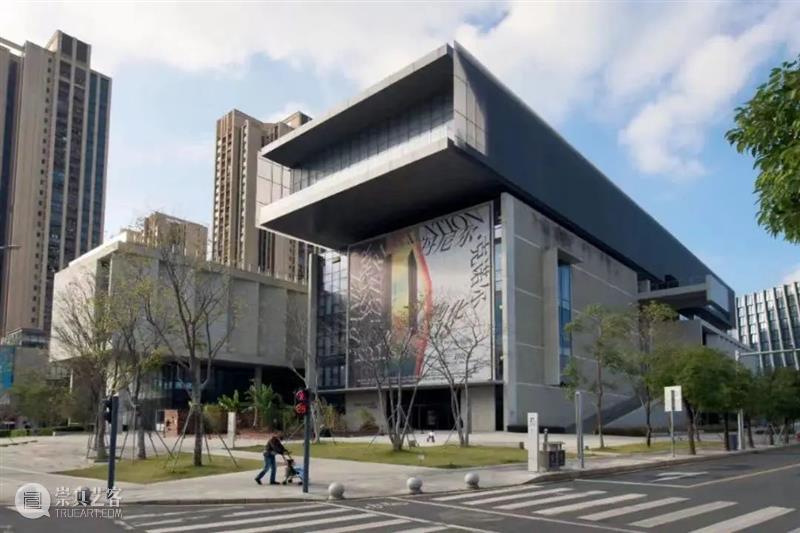
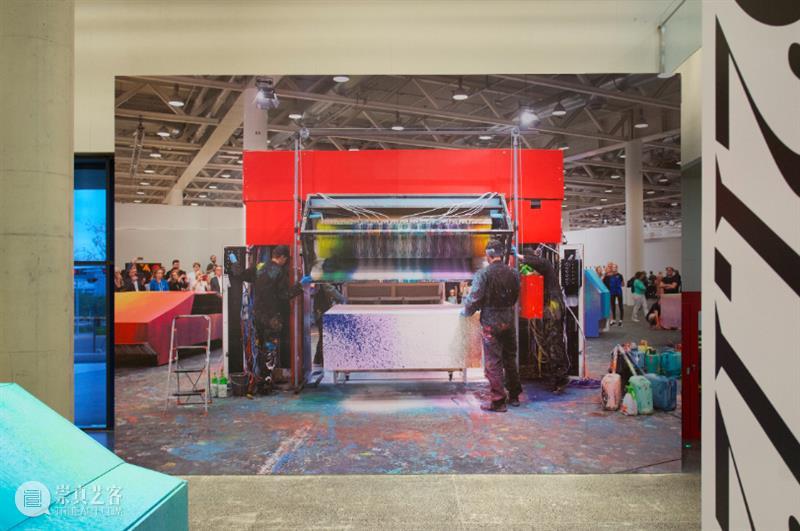
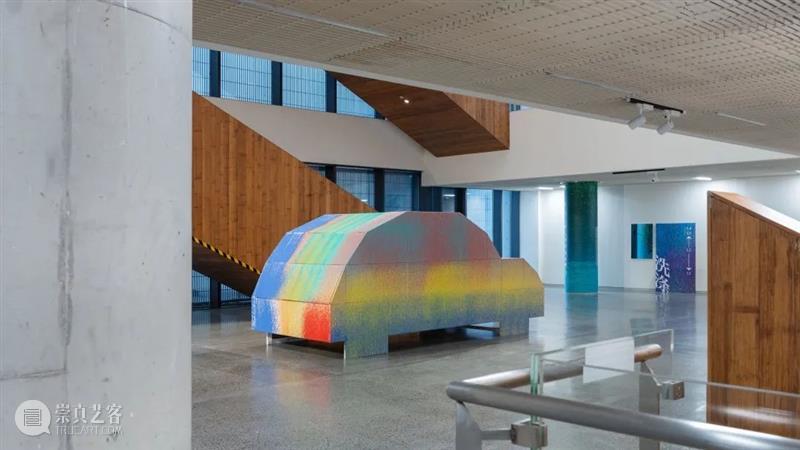

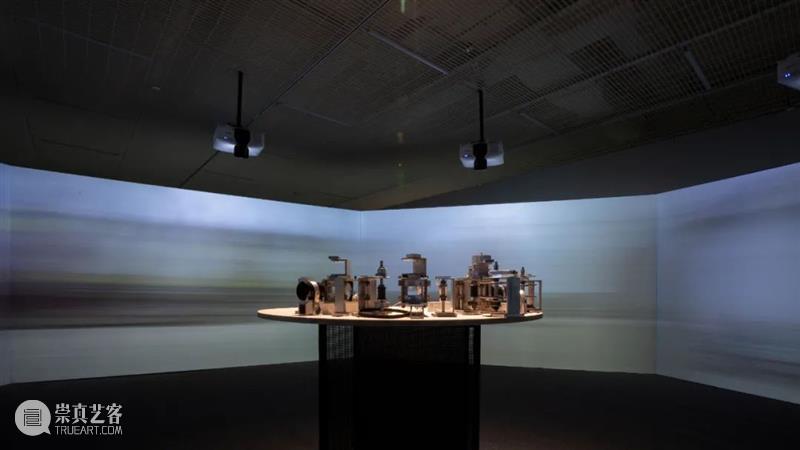
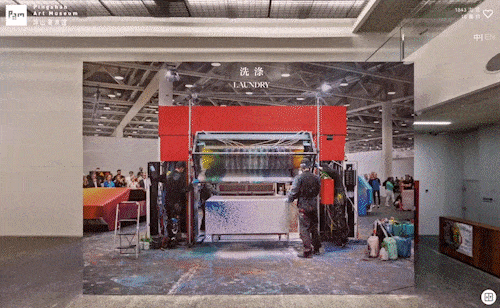
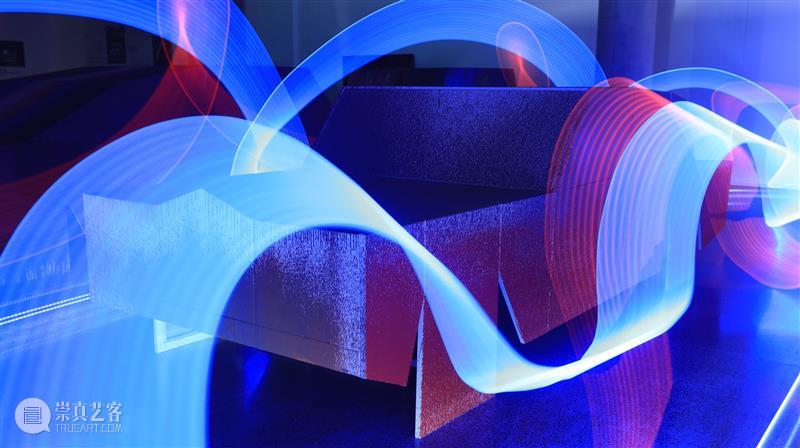





 分享
分享